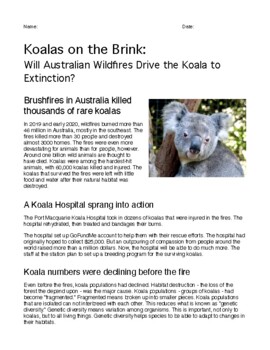UK's Rarest Wildlife: Wildfires Push Species To The Brink Of Extinction

Table of Contents
The devastating impact of wildfires is no longer confined to far-off lands; the UK's rarest wildlife is facing an unprecedented threat. Recent years have seen a dramatic increase in the frequency and intensity of wildfires, significantly impacting vulnerable species and pushing them closer to the brink of extinction. This article explores the devastating effects of these fires on the UK's rarest wildlife, examining the species most affected, the role of climate change, and the crucial conservation efforts underway.
<h2>Species Most Affected by Wildfires in the UK</h2>
Wildfires are devastating habitats crucial for the survival of the UK's most vulnerable creatures. The destruction caused by these infernos leaves behind a landscape unsuitable for many species, leading to population declines and, in some cases, local extinctions.
<h3>The impact on endangered birds</h3>
Several bird species are particularly vulnerable to wildfires. The Dartford warbler, a small, elusive bird found primarily on heathland, relies on specific vegetation for nesting and foraging. Wildfires destroy this habitat, leaving them with limited options for survival. Similarly, the nightjar, a nocturnal bird that nests on the ground, is highly susceptible to fire's destructive power.
- Dartford Warbler: Loss of nesting sites and crucial foraging habitats leads to reduced breeding success and population decline. Studies show a direct correlation between wildfire frequency and Dartford warbler population crashes in affected areas.
- Nightjar: Ground nesting makes them extremely vulnerable to fire, with nests and chicks directly incinerated. The destruction of insect populations, their primary food source, further exacerbates their plight.
<h3>Reptiles and Amphibians Under Threat</h3>
Reptiles and amphibians are particularly sensitive to habitat changes caused by wildfires. The smooth snake, a species dependent on heathland ecosystems, loses its crucial basking sites and shelter from predators after a wildfire. The natterjack toad, a creature of bogs and heathland, faces similar challenges, with wildfires destroying its breeding ponds and altering the delicate microclimate it needs to thrive.
- Smooth Snake: Wildfires destroy their preferred habitats, impacting basking sites and shelter, leading to reduced survival rates and breeding success. The alteration of microclimates makes remaining habitats unsuitable.
- Natterjack Toad: Wildfires dry out breeding ponds and destroy the surrounding vegetation, severely impacting reproduction and survival. Current conservation efforts focus on habitat restoration and pond creation.
<h3>The plight of mammals</h3>
Small mammals such as the hazel dormouse and water vole are also seriously affected. Wildfires destroy their nesting sites and food sources, making them more vulnerable to predation. Habitat fragmentation due to wildfires also isolates populations, reducing genetic diversity and increasing the risk of inbreeding depression.
- Hazel Dormouse: Loss of hazel trees and other woodland vegetation reduces food availability and nesting opportunities. Increased exposure to predators after wildfires further impacts their survival.
- Water Vole: Destruction of riverside habitats impacts food sources and shelter. Increased predation risk after wildfires is also a significant concern.
<h2>The Role of Climate Change in Increasing Wildfire Risk in the UK</h2>
Climate change is significantly increasing the risk of wildfires in the UK. Rising temperatures, prolonged periods of drought, and altered rainfall patterns are creating drier conditions, making landscapes more susceptible to ignition and allowing fires to spread more rapidly.
<h3>Increased frequency and intensity of wildfires</h3>
Data shows a concerning upward trend in both the frequency and intensity of wildfires across the UK. The average summer temperature increase is directly correlated with an increased number of large-scale wildfire events, particularly in vulnerable regions like the South West and East Anglia.
- Rising Temperatures: Longer, hotter summers create tinder-dry conditions, significantly increasing the risk of wildfires.
- Increased Ignition Sources: Human activity, such as discarded cigarettes and barbecues, is a major factor in wildfire ignition.
<h3>The impact of changing weather patterns</h3>
Changes in rainfall patterns contribute significantly to the problem. Less rainfall and more intense periods of drought create fuel-rich landscapes that are highly flammable. This creates a dangerous feedback loop, where wildfires further exacerbate climate change by releasing carbon dioxide and other greenhouse gases into the atmosphere.
- Drought Conditions: Extended periods without rainfall leave vegetation extremely dry and highly combustible.
- Extreme Weather Events: More frequent and intense heatwaves increase the risk of wildfires.
<h2>Conservation Efforts to Protect the UK's Rarest Wildlife</h2>
Protecting the UK's rarest wildlife from wildfire threats requires a multi-pronged approach involving habitat restoration, species-specific conservation programs, and increased public awareness.
<h3>Habitat restoration and management</h3>
Several organizations are actively involved in restoring fire-damaged habitats. Techniques include controlled burns to manage vegetation, replanting native species, and creating firebreaks to prevent the spread of future wildfires.
- The National Trust: Undertakes extensive habitat restoration projects on its land, focusing on creating resilient landscapes less prone to wildfires.
- The RSPB: Focuses on restoring habitats crucial for endangered bird species, improving nesting areas and food sources.
<h3>Species-specific conservation programs</h3>
Various conservation programs are in place to protect specific endangered species. These include breeding programs to increase populations, reintroduction initiatives to restore species to former habitats, and monitoring programs to track population trends and evaluate the success of conservation efforts.
- Dartford Warbler Recovery Programme: Focuses on habitat management and population monitoring.
- Smooth Snake Conservation Project: Aims to protect remaining populations through habitat management and translocation.
<h3>Public awareness and education</h3>
Raising public awareness about wildfire prevention and the importance of protecting vulnerable species is crucial. Educating the public about responsible behavior in the countryside and the importance of reporting wildfires promptly can help mitigate the risk.
- Wildfire Prevention Campaigns: Promote responsible behavior in fire-prone areas.
- Educational Resources: Provide information on the impact of wildfires on wildlife and how to get involved in conservation efforts.
<h2>Conclusion: Protecting the UK's Rarest Wildlife from Wildfire Threats</h2>
Wildfires pose a significant and growing threat to the UK's rarest wildlife, exacerbated by climate change. The destruction of habitats, loss of food sources, and increased predation risk are driving many species closer to extinction. However, through collaborative conservation efforts, habitat restoration, species-specific programs, and increased public awareness, we can mitigate the impact of wildfires and protect these invaluable species for future generations. Learn more about how you can help protect the UK's rarest wildlife and contribute to wildfire prevention efforts by supporting organizations like the RSPB, The Wildlife Trusts, and the National Trust. Together, we can ensure the survival of the UK's most vulnerable creatures.

Featured Posts
-
 Prediksi Pertandingan Atalanta Vs Venezia Analisis Lengkap Serie A Liga Italia
May 13, 2025
Prediksi Pertandingan Atalanta Vs Venezia Analisis Lengkap Serie A Liga Italia
May 13, 2025 -
 Skarlet Gioxanson Oristiki I Apofasi Den Epistrefei Os Black Widow
May 13, 2025
Skarlet Gioxanson Oristiki I Apofasi Den Epistrefei Os Black Widow
May 13, 2025 -
 House Republicans Release Details Of Trump Tax Cut Bill
May 13, 2025
House Republicans Release Details Of Trump Tax Cut Bill
May 13, 2025 -
 Live Stream Texas Rangers Vs Boston Red Sox Mlb Free Online
May 13, 2025
Live Stream Texas Rangers Vs Boston Red Sox Mlb Free Online
May 13, 2025 -
 Bollywood Actresses Who Quit Reasons And Career Impacts
May 13, 2025
Bollywood Actresses Who Quit Reasons And Career Impacts
May 13, 2025
